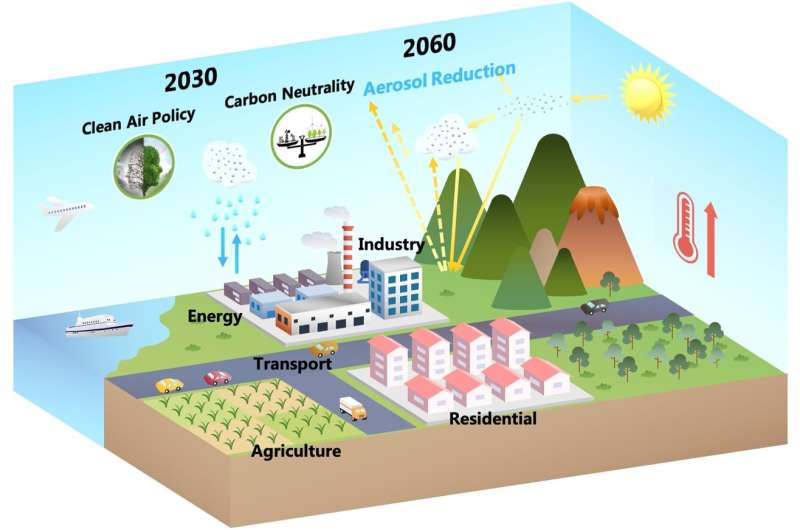This article has been reviewed according to Science X's editorial process and policies. Editors have highlighted the following attributes while ensuring the content's credibility:
fact-checked
trusted source
proofread
Climate effects of future aerosol reductions for achieving carbon neutrality in China

When China pursues the carbon neutrality goal and the long-term air quality target, aerosol reductions will cause temperature increase over eastern China and enhance precipitation over southern China. Black carbon (BC) emission reduction can effectively mitigate the warming effect caused by other aerosol emission reductions under carbon neutrality.
As the largest developing country and a significant contributor to carbon dioxide (CO2), China has announced its ambitious climate commitment to pass carbon peak before 2030 and achieve carbon neutrality by 2060. Aerosols can perturb Earth's radiation balance and influence climate through interacting with radiation and clouds. In the context of pursuing carbon neutrality in China, aerosol reductions related to air pollution control policies are very likely to have a great impact on the climate.
In a study led by Prof. Yang Yang from Nanjing University of Information Science and Technology, the climate effects of aerosol reductions due to China's clean air actions under localized future emission scenarios are investigated using the Community Earth System Model version 1 (CESM1). The work is published in Science Bulletin.
In the near-term future, aerosol reductions will cause 0.2–0.5 K of temperature increase over eastern China in 2030 under a carbon neutrality scenario. In the long-term future, air temperature in 2060 will increase over 0.5 K in over eastern China due to the future clean air actions. Accompanied by the increase in temperature and the decrease in aerosols competing for cloud water, annual mean precipitation will be enhanced over southern China and the downwind northwestern Pacific with maximum increases of 0.2–0.3 mm d-1 in 2030 and exceeding 0.3 mm d-1 in 2060 due to clean air actions in China under the carbon neutrality scenario compared to 2015.
Although the reduction in greenhouse gases under carbon neutrality directly benefits the climate change mitigation, the reduction of aerosol and precursor emissions due to future clean air actions in China could partly offset the radiative cooling of CO2 emission reduction. In the carbon peak year (2030) in China, the cooling and warming at the surface caused by the decreases in BC and other scattering aerosol emissions will almost offset each other in East Asia. In the year (2060), the significant decrease in scattering aerosol emissions in China will lead to an average temperature increase of 0.36 K in East Asia, about half of which could be dampened by the reduction in BC emissions in China under the carbon neutrality scenario.
"Although BC only accounts for a small fraction of aerosols in China, future clean air actions of reducing BC emissions are potentially favorable to achieving the co-benefits for air quality and climate mitigation under carbon neutrality." Prof. Yang says.
The study can provide a scientific reference for China to develop carbon-neutral pathways, targets and policies, and also provide theoretical support to achieve the co-benefits for air quality and climate mitigation under carbon neutrality.
More information: Yang Yang et al, Climate effects of future aerosol reductions for achieving carbon neutrality in China, Science Bulletin (2023). DOI: 10.1016/j.scib.2023.03.048
Provided by Science China Press





















